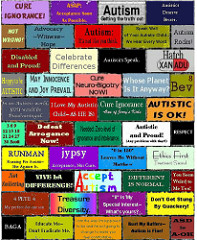It’s too easy for blogging to end up as nothing more than a series of rants, so here’s something positive.
It’s that time of year when millions of people (leastwise, those in the northern hemisphere) are starting new school years. As someone who tutors (other) students with ADD and learning disabilities, I thought I’d share a bevy of helpful ideas I’ve scraped together over the years.
GETTING READY TO READ
Put the material into the Big Picture. Before starting a chapter/ module/ unit, review your syllabus to see how the content of this one fits within the logical flow of the previous unit, and how it might be important to the next unit. This helps the material make more sense and seem less like a giant pile of loose facts.
Read the textbook backwards. Start with the Summary in the back of the chapter; this is the “TV Guide” version to what the chapter is about, so you know what you’re heading into before you dive into all the excruciating details. Read over the new terms in the Glossary, so when you encounter them in the text you won’t have those unintelligible speed-bumps that interrupt your understanding of the reading.
This is helpful if this subject is entirely new to you and you have little or no background in the concepts and terminology of this particular field of study.
From the first day of class, create a personal glossary of new terms and their definitions. This is imperative if you are starting a new field of study because you will soon find yourself in possession of a swarm of new words for which you are responsible. Trying to look up a word for its definition by flipping through masses of notes, handouts and textbooks only slows you down and makes you frustrated. Staring into space, pacing, rocking or banging your head do not aid in remembering new terms, so having that personal glossary will give you a ready list to access. Don’t forget to add helpful tips to your definitions, such as cautions about similar-sounding words that you might confuse, or terms with complementary or opposite meanings.
This is especially helpful if you are slow at recalling words, or have difficulties with spelling.
Block off distracting printed material with a mask. Use a half sheet of thin cardboard, a 3/4 sheet cut into an “L” shape, or two blank index cards to mask off distracting graphics, or simply to block off everything but the single question, objective, or paragraph you need to focus upon.
This is helpful if you are someone who is easily distracted by fascinating pictures, or if you have reading difficulties.
TAME THE PAPER TIGER
Assign a particular color to each class. I like to have the binder match the textbook color, so when I’m getting things together for class I only have to grab “two red things”. After the test, keep the notes and handouts in the colored binder or manilla folder. Use that color of ink to mark due dates for assignments and test dates on your calendar. Use that color of manilla or pocket folder to keep all the stray bits of useful stuff you are collecting for a report/project – having that special “parking place” will help organize and reduce the “file by pile” mess on your desk, floor, table, window ledge and other random surfaces…
Buy a hole punch with a trap. The trap collects all the “dots” so they don’t litter the floor. A 3- or 4-hole punch (depending on whether you use 8.5″ x 11″ or A4 paper) is vastly easier than a single-hole punch, as it not only reduces the number of clenches you have to perform, but also because it makes hole spacing that is perfectly even for the binder. Hole-punch all of your handouts and put them into the binder with your notes, so the two can live in wedded bliss.
Buy several packages of index dividers so you can separate the different chapters/units in your binder and more quickly flip through them for studying.
Make liberal use of colored sticky-notes. These are the greatest invention since the microwave oven! They will save tremendous amounts of time from having to endlessly flip through textbook, lab manual, handout, and note pages to track down important information.
Use colored sticky-notes to mark where important graphs, lists, charts, and diagrams are located in the textbook – write a key word on the external, flagging end of the sticky.
Use different colors of sticky-note for different chapters/modules/units, to make studying easier when you have tests that come after you have begun the next chapter/module/unit.
Use sticky-notes to mark chapter sections for those classes that skip around a lot within a textbook. If you are only using section 3.2 of a chapter, then you may begin by reading the summary for just section 3.2 of that chapter, but it might also be helpful to briefly review what the rest of the chapter summary has to say, to understand how the ideas in this section are connected to other ideas.
NOTABLE TIPS FOR NOTE-TAKING & STUDYING
Always take notes in black ink. There is nothing more horrifying during Midterm or Final Exams than discovering that a semester’s worth of pencil-written lecture notes has turned into a smeary, unreadable mess. Oh, the horror… Also, some kinds of blue ink are close to “non-photo / non-repro” blue, a color that’s nearly invisible to many photocopiers; this is usually not a problem unless you need to photocopy those notes for any reason.
Always date and/or number your note pages. Of course, if you live a charmed life and never have sudden “gravity fluctuations” in your part of the planet that cause you to drop or spill note papers, or you never own binders that lose their “bite”, then don’t bother. Otherwise, dating the pages lets you keep track of what was lectured on at a particular time (handy if someone asks to borrow your notes from last Tuesday). If you take more than one page of notes per day (which is nearly always) then numbering the pages instead of or in addition to dating them makes it even easier to put spilled pages back to rights.
Title each page. Even if it’s just by abbreviation, describe the page of notes by the lecture topic, the unit or chapter title. This not only makes it easier to find the right notes when studying for tests, but it also helps you remember what the overall pattern of ideas is during the course of the class across the semester.
Example:
MITOSIS WED 2 FEB p.1
Take notes in two columns: the left side for listing the main idea titles, important names, terms, dates or formulae, and the right side for all the regular details and sentences. If there is a page in your textbook, lab manual or whatever that has a particular graph, chart or listing, write down that page number on the left side as well, as well as a word or two to title why that page number is important. This speeds up your test studying because you can glance through pages of notes to find the one that has the specific information you’re looking for.
Use the Objectives listed in the chapter/unit/module as your study guide for the test, and write out a full answer to each one as though it were a question. Pay attention to key verbs such as Describe, Compare, List, Define or Identify – these can give you an idea of what kind of test question could be asked. Writing these out does two things: it not only helps you self-test your own understanding before you get to the class test, but it also changes your answers from something you have to invent during the test (which is time-consuming) into something you just have to recall during the test (which is much quicker and easier).
Writing out answers to the objectives in full sentences is especially helpful if English is not your first language, and/or if you are slow at remembering words,and/or otherwise have difficulty expressing the knowledge that’s stuck in your head.
DECIMATED BY NUMBERS
Turn lined paper sideways to have ready-made columns for keeping your place-values straight in big arithmetic calculations. Another option is to use green “engineer’s paper” that has graph squares on one side and is blank on the other side, but the graph grid is still somewhat visible on the blank side, and the green tint is more restful on the eyes.
This is especially helpful if your handwriting tends to wander around or slope down a page, and will keep your numbers and decimals in order.
If you are doing mathematical equations or other things that are processes, write out your own set of numbered directions describing how to do the process. For instance, it may not be as obvious to you as it was to the author of the formula that you need to determine the value of “C” before you put the other values into the formula. So in your own directions, you should note “Find the value for “C” by ~ ~ ~” as one of the earlier steps.
Whenever you solve an equation or do a statistical analysis, write out in a complete sentence what the answer to the calculations MEANS in regards to the original problem/story/question given.
These are especially helpful if you are more of a “words” person than a “numbers” person.
If you have several different formulae , make yourself a flow-chart (meaning, a series of decisions) that helps you figure out which one you use for different kinds of circumstances. When you are studying a chapter or doing that day’s homework, it’s obvious which one you need to use – it’s the one you’re learning that day! But come test time, you will need to be able to understand which one you use for each kind of situation.
This is especially helpful if you are one of those people for whom “all the formulae look the same”.
Use name and address labels on everything, and add your phone number or email as well. Put them on your textbooks, lab manuals, various notebooks, calculator, data CD, flash/keychain drive, assorted binders, notepads, calendar-organizer, each piece of art & drafting equipment plus the carrying case, and all the other things that you need to survive as a student, to help guarantee that the person who finds them can help get them back home to you.
This is especially helpful if you are forgetful, distractible, prone to leaving things in various places, and/or are juggling a variety of classes and jobs. (You can imagine why I know this.)









You must be logged in to post a comment.